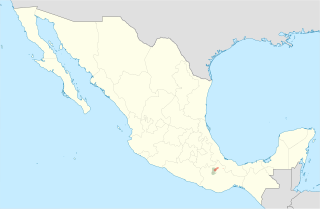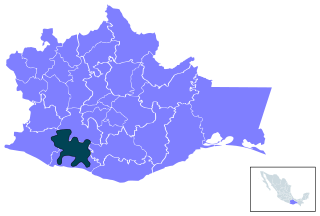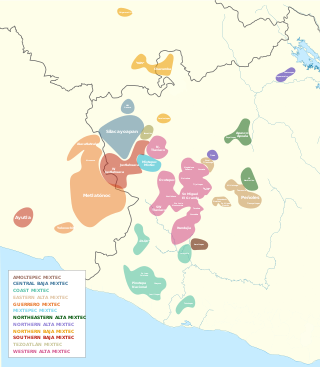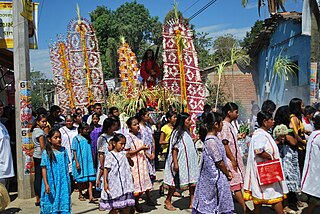Related Research Articles

The Chinantec or Chinantecan languages constitute a branch of the Oto-Manguean family. Though traditionally considered a single language, Ethnologue lists 14 partially mutually unintelligible varieties of Chinantec. The languages are spoken by the indigenous Chinantec people who live in Oaxaca and Veracruz, Mexico, especially in the districts of Cuicatlán, Ixtlán de Juárez, Tuxtepec and Choapan, and in Staten Island, New York.

The Oto-Manguean or Otomanguean languages are a large family comprising several subfamilies of indigenous languages of the Americas. All of the Oto-Manguean languages that are now spoken are indigenous to Mexico, but the Manguean branch of the family, which is now extinct, was spoken as far south as Nicaragua and Costa Rica. Oto-Manguean is widely viewed as a proven language family. However, this status has been recently challenged.

The Mazatecan languages are a group of closely related indigenous languages spoken by some 200,000 people in the area known as the Sierra Mazateca, which is in the northern part of the state of Oaxaca in southern Mexico, as well as in adjacent areas of the states of Puebla and Veracruz.

Amuzgo is an Oto-Manguean language spoken in the Costa Chica region of the Mexican states of Guerrero and Oaxaca by about 44,000 speakers. Like other Oto-Manguean languages, Amuzgo is a tonal language. From syntactical point of view Amuzgo can be considered as an active language. The name Amuzgo is claimed to be a Nahuatl exonym but its meaning is shrouded in controversy; multiple proposals have been made, including 'moss-in'.

The Mixtec languages belong to the Mixtecan group of the Oto-Manguean language family. Mixtec is spoken in Mexico and is closely related to Trique and Cuicatec. The varieties of Mixtec are spoken by over half a million people. Identifying how many Mixtec languages there are in this complex dialect continuum poses challenges at the level of linguistic theory. Depending on the criteria for distinguishing dialects from languages, there may be as few as a dozen or as many as fifty-three Mixtec languages.

Otomi is an Oto-Pamean language family spoken by approximately 240,000 indigenous Otomi people in the central altiplano region of Mexico. Otomi consists of several closely related languages, many of which are not mutually intelligible. The word Hñähñu[hɲɑ̃hɲṹ] has been proposed as an endonym, but since it represents the usage of a single dialect, it has not gained wide currency. Linguists have classified the modern dialects into three dialect areas: the Northwestern dialects are spoken in Querétaro, Hidalgo and Guanajuato; the Southwestern dialects are spoken in the State of Mexico; and the Eastern dialects are spoken in the highlands of Veracruz, Puebla, and eastern Hidalgo and villages in Tlaxcala and Mexico states.

Cuicatec is an Oto-Manguean language spoken in Oaxaca, Mexico. It belongs to the Mixtecan branch together with the Mixtec languages and the Trique language. The Ethnologue lists two major dialects of Cuicatec: Tepeuxila Cuicatec and Teutila Cuicatec. Like other Oto-Manguean languages, Cuicatec is tonal.

Chatino is a group of indigenous Mesoamerican languages. These languages are a branch of the Zapotecan family within the Oto-Manguean language family. They are natively spoken by 45,000 Chatino people, whose communities are located in the southern portion of the Mexican state of Oaxaca.

The state of Oaxaca, Mexico has a total population of about 3.5 million, with women outnumbering men by 150,000 and about 60% of the population under the age of 30. It is ranked tenth in population in the country. Fifty three percent of the population lives in rural areas. Most of the state’s population growth took place between 1980 and 1990. Life expectancy is 71.7 for men and 77.4 for women, just under the national average. Births far outpace deaths. In 2007, there were 122,579 births and 19,439 deaths. Approximately 85% profess the Catholic faith.
Tilquiapan Zapotec is an Oto-Manguean language of the Zapotecan branch, spoken in southern Oaxaca, Mexico.

The internal classification of Mixtec is controversial. Many varieties are mutually unintelligible and by that criterion separate languages. In the 16th century, Spanish authorities recognized half a dozen lenguas comprising the Mixtec lengua. It is not clear to what extent these were distinct languages at the time. Regardless, the colonial disintegration of the Mixtec nation and resulting isolation of local communities led to the rapid diversification of local dialects into distinct languages. Below are some attempts at Mixtec classification by various scholars.

The Amuzgos are an indigenous people of Mexico. They primarily live in a region along the Guerrero/Oaxaca border, chiefly in and around four municipalities: Xochistlahuaca, Tlacoachistlahuaca and Ometepec in Guerrero, and San Pedro Amuzgos in Oaxaca. Their languages are similar to those of the Mixtec, and their territories overlap. They once dominated a larger area, from La Montaña down to the Costa Chica of Guerrero and Oaxaca, but Mixtec expansion, rule and later Spanish colonization has pushed them into the more inaccessible mountain regions and away from the coast. The Amuzgos maintain much of their language and dress and are known for their textiles, handwoven on backstrap looms with very intricate two-dimensional designs. The Amuzgo area is very poor with an economy mostly dependent on subsistence agriculture and handcraft production.
Zaniza Zapotec is an Oto-Manguean language of western Oaxaca, Mexico. It is one of several Zapotec languages called Papabuco. It has only 10% intelligibility with Texmelucan Zapotec, its closest important relative.
Silacayoapan is one of the more extensive Mixtec languages. It is spoken by 150,000 people in Puebla and across the border in Guerrero, as well as by emigrants to the United States.
Atatláhuca–San Miguel Mixtec is a diverse Mixtec language of Oaxaca.
Cuyamecalco Mixtec is a Mixtec language of Oaxaca spoken in Cuyamecalco, San Miguel Santa Flor, and Santa Ana Cuauhtémoc. Egland & Bartholomew had found Cuauhtémoc to be more intelligible with Coatzospan Mixtec, which in any case is close to Cuyamecalco.
Estetla Mixtec is a diverse Mixtec language of Oaxaca.
Ñumí Mixtec is a diverse Mixtec language of Oaxaca. It may be closest to Peñasco Mixtec.
Mixtepec Mixtec is a Mixtec language that is spoken in the lower Mixteca region. Mixtec language is largely spoken in the area of San Juan Mixtepec, district of Juxtlahuaca, state of Oaxaca. However, the language is also spoken in other areas including Tlaxiaco, San Quintín Baja California, Santa María California, and Oregon. In 2004, it was reported that approximately 12,000 people spoke the Mixtepec Mixtec language. While most speakers of the language refer to it as 'sa'an ntavi' meaning 'language of the poor' or 'poor people's language,' others refer to it as 'sa'an save' which means 'rain language.' It is not closely related to other varieties of Mixtec.
Yucunicoco Mixtec is a Mixtec language of Oaxaca.
References
- ↑ Egland & Bartholomew (1983) La Inteligibilidad Interdialectal en México